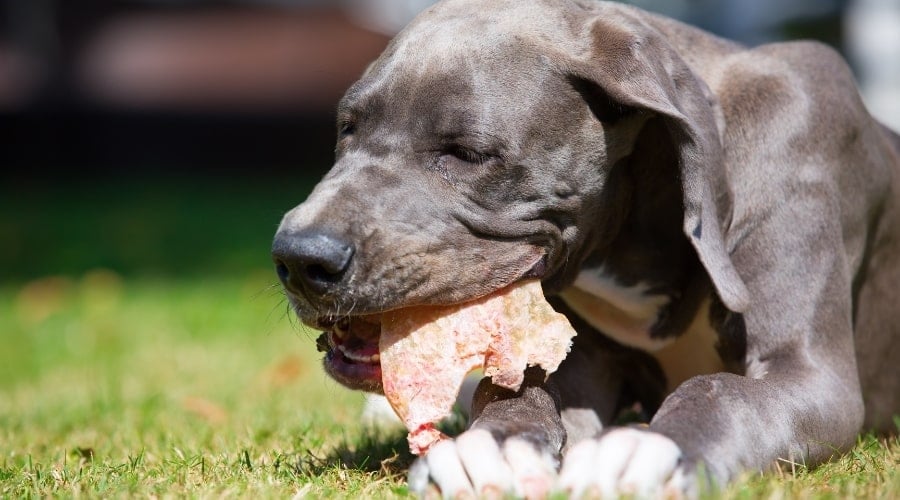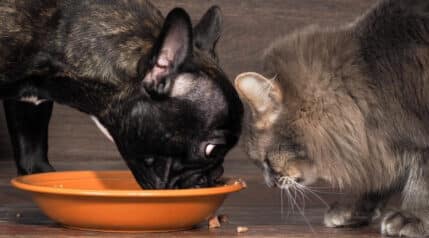Are pig ears safe for dogs? Are you thinking about feeding your pup some pig ears as a treat or snack? Maybe you just did and want to double-check that pig ears are safe for dogs. In most cases, pig ears are fine as treats. But there are some things to consider before feeding your pup a pig ear as a chew toy. There may also be some better alternatives for a teething puppy or a senior dog that needs dental care.
Pork is something humans and canines both consume fairly regularly. Not many people are interested in what might be considered the less-savory parts of the pig, such as the kidneys, liver, and ears. One way to use up as much of the pig as possible is to repurpose these as additions to our dogs’ daily menu. Our canine companions are far less picky than we are when it comes to food. The use of these animal by-products as an ingredient in kibble is one way to use up these nutritious parts of a healthy animal carcass.
Of course, some bits can also be fed as treats. Pig ears, specifically, appear to be growing in popularity. They are becoming more commonly found in pet stores as packaged treats, and people are increasingly looking to prepare them at home using raw ingredients from a local butcher.
How Are Pig Ear Treats Made?

When it comes to chewing treats, most of the products are either baked or dehydrated. Blanching may also be included as a processing step. This is when a quick bath of boiling water is used to remove the small hairs that can be found on the pig’s ear.
These hairs won’t cause any harm to your dog, but removing them makes for a cleaner-looking end product. Most commercial pig ear products don’t have anything added during or after processing. The crunch and flavor of the ears themselves are enough to make for a highly enticing treat.
Can I Make My Own?
Pig ear dog treats are sold everywhere and are easy to find. If you are still keen to prepare pig ears at home, ensure that you are collecting fresh ears from a reputable butcher. Keep in mind that because you will be working with a raw meat product, all in-contact surfaces will have to be properly disinfected.
Some people will want to feed their dog the raw product, but this can put them at risk of digestive issues and possible food poisoning. Additionally, raw-fed dogs can carry and shed the harmful bacteria found in their food. For this reason, raw feeding is generally discouraged, especially in households with vulnerable or immune-compromised individuals.
It is best to cook your pigs’ ears before feeding. Your dog will probably not have a preference between cooked or raw anyway. At home, you can prepare the ears in much the same way as the commercial companies. When you first bring them home, give them a good wash to remove any lingering dirt and debris. Blanching will serve as an extra cleaning step to remove any small hairs. The ears can then be baked or dehydrated at a recommended minimum temperature of 160⁰F.
Are Pig Ear Treats Healthy For Dogs?

Are pig ears good for dogs? According to the USDA, one cooked pig’s ear contains 29g protein, 15g fat, and 64g water. It also contains a range of nutrients, such as iron, calcium, magnesium, and phosphorus. This will vary between the manufacturer and the cooking method. Universally, though, they are high in calories, with around 264 calories each. Pig’s ears should be seen as a treat, not a part of the diet. While they will provide some basic nutrition, the calorie count is too high for them to be considered healthy.
Pigs’ ears should, therefore, only be given as an occasional treat unless you are working with a board-certified nutritionist to create a balanced diet that specifically includes pigs’ ears. Only 10% of your dog’s daily calories should be coming from an unbalanced source, such as pig ear chews. Your vet can help you determine the total number of calories your dog will need in a day and how to fit treats into the menu.
If you are using a commercial product, you can check the package for the calorie count. If one is not available or you are feeding homemade chews, you can assume that one ear will roughly be about 264 calories. You may find that you can only feed half an ear to stay within your dog’s daily intake limit, or you might want to find a product that is pre-cut and portioned for dogs with a lower daily energy requirement.
Are They Good For Cleaning Teeth?
There is evidence that teeth will appear cleaner after using a hard chew. But tartar can still linger below the gum line. There isn’t any strong evidence at the moment that the use of any treats can prevent periodontal disease. The only exception is treats made specifically to improve dental health. The best way to ensure that your dog’s pearly whites stay clean and shiny is to brush their teeth using dog-friendly toothpaste on a regular basis.
Are Pig Ear Chews Safe?

People often ask, are dried pig ears safe for dogs? Pig ears are considered to be safe for dogs. But there has been some controversy about using them in the last several years. Feeding your pup pig ears is a personal choice. But there are a few things to keep in mind before you feed them to your dog, including intestinal blockages, higher fat content, and Salmonella.
Many people ask about pig ears for puppies. Pig ears for puppies can be a safe treat, but only in strict moderation and under close supervision. They can be a healthier alternative to rawhide or other treats made with artificial flavors and dyes.
Intestinal Blockages
If you are feeding pig ears as a crunchy chew toy, dogs should be supervised during their play session. Pig ear chews are very hard and break easily into pieces. This means there’s a risk of choking and intestinal obstruction. If you notice your dog salivating excessively or coughing repeatedly during a play session, it is likely that a part of the treat got stuck somewhere in the mouth or esophagus. This is an emergency, and you should see your veterinarian immediately.
Even if a big chunk is able to pass into the stomach, the connective tissue and skin on the pig ear are not easily digested and may be unable to break down without having been chewed first. There have been reports of dogs with pig ear bits stuck in their stomach, requiring surgery to treat. If your dog is going to be eating pig ear chews on a regular basis, know how to recognize the signs of blockages lower down in the gastrointestinal tract. This includes vomiting, diarrhea, changes in appetite, or abdominal pain. If you notice that your dog doesn’t chew his pig ear before swallowing, an alternative chewing treat would probably be a better bet for playtime.
Salmonella Contamination
As with many products on the market, there will be recalls from time to time. The most recent recall occurred in September 2019 in response to people getting sick from Salmonella poisoning after handling pigs’ ear treats. The treats had been shipped in from abroad and were found to be infected with salmonella, which was being transferred to the people in the household- either through direct contact with the ear or through the dog.
Situations such as these are good reminders to always wash your hands after handling any of your dog’s food or treats. There is always a potential for contamination when handling a meat product, especially one that is kept at room temperature. The Food and Drug Administration is closely involved with pet treat manufacturers to prevent any dangerous pathogens from being found in our dogs’ food and treats in the first place.
You can check the Food and Drug Administration (FDA) website for a full report and the list of products involved in the most recent recall. To stay up-to-date on recalls, you can use the FDA safety alert website.
Pig Ear Fat Content
There is some concern that the high-fat content in pigs’ ears could cause pancreatitis in dogs. Certainly, some dogs appear to be very susceptible to this. They may get vomiting, diarrhea, and abdominal pain after eating a pig’s ear. This is probably more likely if your dog is small or has a sensitive stomach.
It can be more prevalent if your dog is already on a diet that is high in fat or is prone to pancreatitis. However, any dog can react to pig ears negatively. Watch your dog carefully, especially if it’s their first time having one. The high fat content and calorie count can also contribute to obesity. This is already a growing problem for pet owners in the US.
Do Pig Ears Make Good Chew Toys?

It is true that most dogs will love having something to chew on. Dogs explore their world using their mouth. Having something to satisfy this exploratory urge is essential to prevent chewing behaviors from being directed to furniture. If your canine companion has to be left on his own for a length of time, a chew toy is a great way to prevent boredom and curb any separation anxiety.
Puppies are also notorious chewers. They will chew on anything they can get their teeth on. This is especially true when their adult teeth are coming in, and they’re trying to relieve the associated soreness. Chew toys are definitely something you’ll want to have available for your dog. Stick to toys that won’t break apart or can be swallowed during unsupervised play. Toys also won’t be accompanied by the high-calorie count found in pig ear chews. This way, you won’t have to worry about fitting them around the diet.
Is Rawhide A Better Alternative?
Rawhide is very similar to pigs’ ears. It’s also made out of the thick connective tissue from the hides of cattle. Because of this, rawhide chews need to be given with the same care as pigs’ ears. Dogs should be monitored for signs of choking or intestinal obstruction. To reduce this risk, some rawhide products are now being produced with multiple layers compressed together.
You’ll be able to find it sold as compressed rawhide. It will be less likely to break into small pieces, which can lead to health hazards. Rawhide has recently come under fire because of the chemicals it can be treated with. Getting rawhide made in the US and checking the packet for hidden extras is one way to mitigate this risk if you want to feed your dog rawhide.
Some lower-risk alternatives are manufactured chewing treats that crumble or are made to dissolve easily once ingested. Additional advantages to using these treats are that they are generally lower in calories than natural products. Some are even made in “weight-reducing” formulas, so they can more easily fit into your pooch’s diet.
Other Healthy Alternatives
There are several other chew-oriented alternatives that provide your pup with some nutrient benefits. Some items we’d recommend are diced zucchini or some sliced sweet potatoes. You’ll want to make sure these are all bite-sized enough for your pup to swallow after a chew session.
You can also freeze them and thaw them slightly so it provides your pup something to chew on for a while, rather than just wolfing it down as an actual treat. Some dog owners will freeze large pineapple chunks or watermelon, giving their pup something to chew on while soothing their gums.
For dogs who need a healthier chew alternative, owners can consider bully sticks. Bully sticks are made from high protein beef muscle (the pizzle or penis of a bull). Bully sticks are safe, easier to digest, and do not pose the same risk of intestinal blockage as rawhide or some other options. They also support healthy teeth, gums, skin, and coats.
Final Thoughts
Pigs’ ears are not the healthiest treat for your dog, and they can cause problems such as blockages and pancreatitis. They can also pose a risk to humans. So, it’s important to follow all hygiene practices, such as washing your hands after handling. However, if you do want to give your dog a pig’s ear, you should make sure they’re from a reliable source. You also need to supervise your dog during treat time. Don’t let your dog have one more often than weekly due to the high-calorie count.






Very interesting article. I got a “new” dog from the Baja Animal Sanctuary. He is a Belgian Shepherd, and he loves pigs’ ears. He eats them like people eat potato chips. After reading your article, I won’t give him as many as I used to.
Thanks for the information !